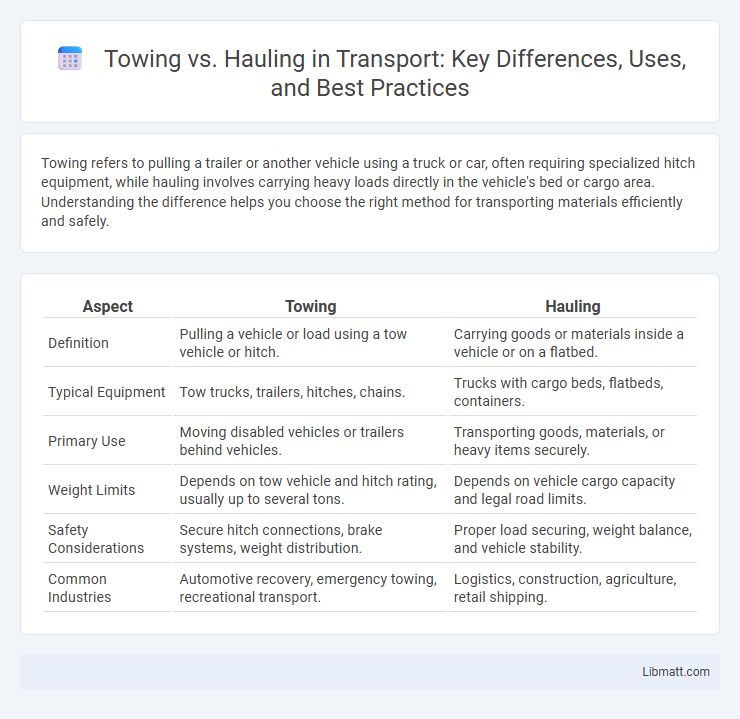Towing refers to pulling a trailer or another vehicle using a truck or car, often requiring specialized hitch equipment, while hauling involves carrying heavy loads directly in the vehicle's bed or cargo area. Understanding the difference helps you choose the right method for transporting materials efficiently and safely.
Table of Comparison
| Aspect | Towing | Hauling |
|---|---|---|
| Definition | Pulling a vehicle or load using a tow vehicle or hitch. | Carrying goods or materials inside a vehicle or on a flatbed. |
| Typical Equipment | Tow trucks, trailers, hitches, chains. | Trucks with cargo beds, flatbeds, containers. |
| Primary Use | Moving disabled vehicles or trailers behind vehicles. | Transporting goods, materials, or heavy items securely. |
| Weight Limits | Depends on tow vehicle and hitch rating, usually up to several tons. | Depends on vehicle cargo capacity and legal road limits. |
| Safety Considerations | Secure hitch connections, brake systems, weight distribution. | Proper load securing, weight balance, and vehicle stability. |
| Common Industries | Automotive recovery, emergency towing, recreational transport. | Logistics, construction, agriculture, retail shipping. |
Towing vs Hauling: Key Differences Explained
Towing involves pulling a trailer or vehicle with a hitch attached to your vehicle, requiring specific towing capacity and appropriate hitch types. Hauling refers to carrying cargo directly on your truck bed or inside a vehicle, focusing on payload capacity and secure load management. Understanding your vehicle's towing versus hauling capabilities ensures safety and efficiency in transporting heavy loads.
Definitions: What is Towing? What is Hauling?
Towing refers to the process of pulling a vehicle, trailer, or load using a hitch or other connection point, typically involving the movement of items that cannot move on their own. Hauling involves transporting cargo or goods in a truck bed, trailer, or other carrying area, emphasizing the weight and volume of the load itself. Both towing and hauling require vehicles designed to handle specific weight capacities, with towing focusing on pulling capacity and hauling concentrated on load-bearing ability.
Typical Equipment Used for Towing and Hauling
Towing typically involves equipment such as trailers, hitches, and tow bars designed to connect vehicles securely for transporting cars, boats, or heavy machinery. Hauling relies on trucks with cargo beds, flatbeds, or dump beds capable of carrying loose materials, large loads, or construction supplies directly. Your choice between towing and hauling depends on the type of equipment needed to move goods efficiently and safely.
Common Applications: When to Tow vs When to Haul
Towing is ideal for transporting vehicles, trailers, boats, or campers over long distances without occupying cargo space, typically used for vacations, vehicle recovery, or commercial transport. Hauling suits heavy, bulky loads like construction materials, furniture, or landscaping equipment directly in a truck bed or trailer, commonly applied in construction, moving, and agriculture. Choosing between towing and hauling depends on the load type, distance, and available vehicle capacity, ensuring safety and efficiency.
Vehicle Requirements for Towing and Hauling
Towing requires a vehicle equipped with a high-capacity hitch receiver, a transmission cooler, and a powerful engine, often a V6 or V8, to manage the additional strain. Hauling demands a robust suspension system, reinforced cargo bed, and higher payload capacity to safely carry heavy loads within the vehicle itself. Both towing and hauling necessitate proper brake systems, tire ratings, and weight distribution capabilities to ensure safety and performance on the road.
Safety Considerations for Towing and Hauling
Safety considerations for towing and hauling include ensuring the vehicle's towing capacity matches the load weight to prevent mechanical failure and maintain control. Properly securing cargo with high-quality straps and utilizing trailer brakes reduces the risk of accidents and improves stability on the road. Regular inspections of tires, hitch connections, and lighting systems are critical to avoid malfunctions during transport.
Load Capacity and Weight Distribution Comparison
Towing and hauling both require careful consideration of load capacity and weight distribution to ensure safety and vehicle performance. Towing capacity refers to the maximum weight your vehicle can pull, including trailers and their cargo, while hauling capacity focuses on the weight your truck bed or cargo area can carry directly. Proper weight distribution helps prevent sway, improves braking, and maintains vehicle stability during transport.
Legal Regulations for Towing and Hauling
Legal regulations for towing and hauling vary significantly by location, with strict rules governing trailer weight limits, brake requirements, and licensing. Towing often requires compliance with specific vehicle-to-trailer ratios to ensure safety and avoid penalties, while hauling focuses on load distribution and securing cargo properly. Understanding your local Department of Transportation laws and obtaining necessary permits can protect you from fines and enhance road safety.
Costs Associated with Towing and Hauling
Towing typically involves expenses such as fuel consumption, vehicle wear and tear, and potential towing equipment costs, which can vary widely based on the weight and distance of the load. Hauling costs often include fuel, maintenance on heavy-duty suspension systems, and permits for oversized or overweight loads, making it potentially more expensive than towing for long distances. You should evaluate the specific costs related to your vehicle type, load requirements, and travel distance to determine the most cost-effective option.
Choosing the Right Method: Towing or Hauling?
Choosing the right method between towing and hauling depends on the type, weight, and configuration of the load. Towing is ideal for transporting vehicles or trailers that can be attached via a hitch, while hauling suits heavy, bulky items loaded directly onto a truck bed or flatbed trailer. Evaluating factors like load stability, legal weight limits, and vehicle capacity ensures safe and efficient transportation.
towing vs hauling Infographic

 libmatt.com
libmatt.com